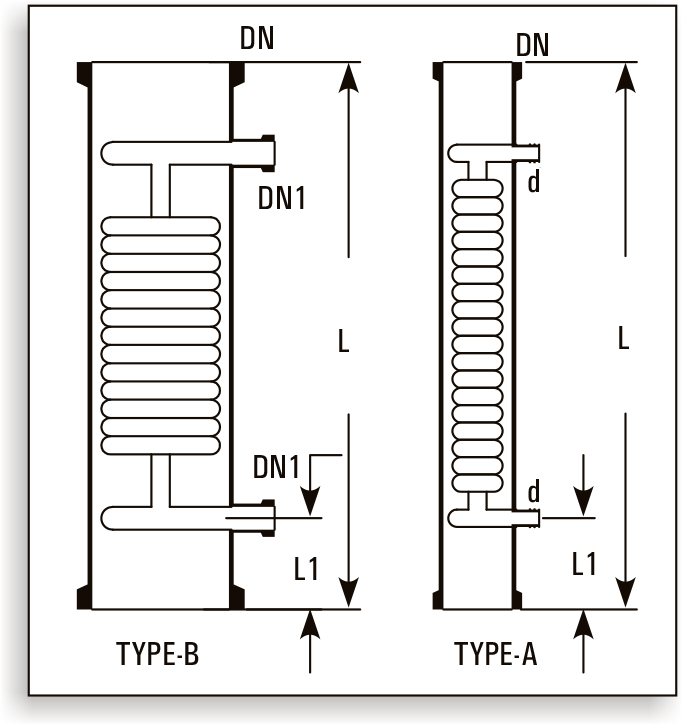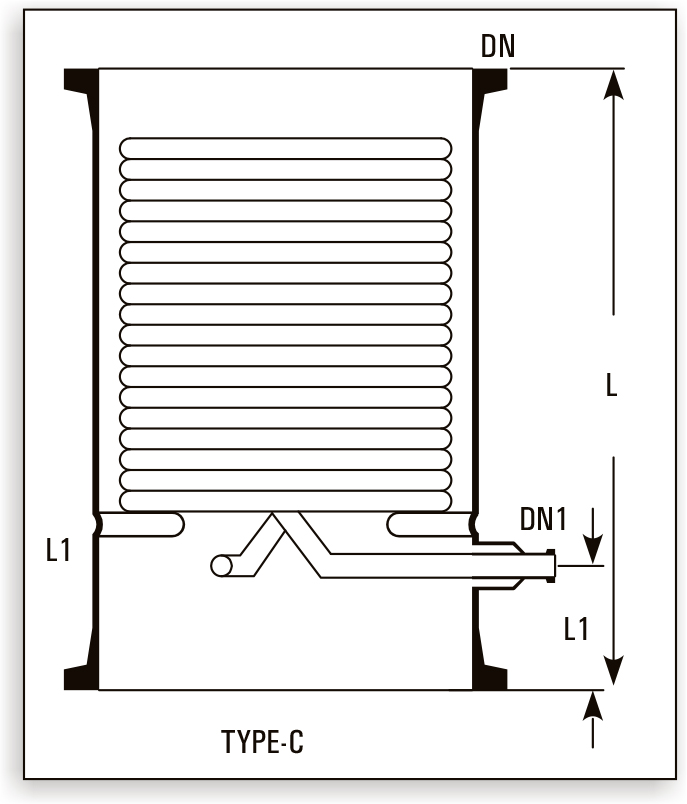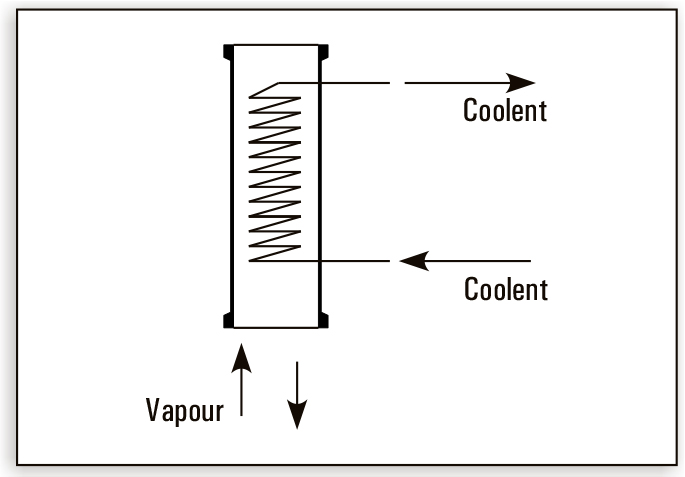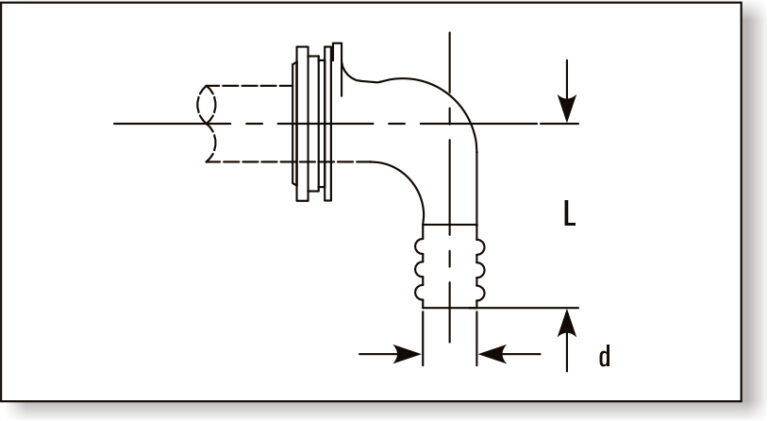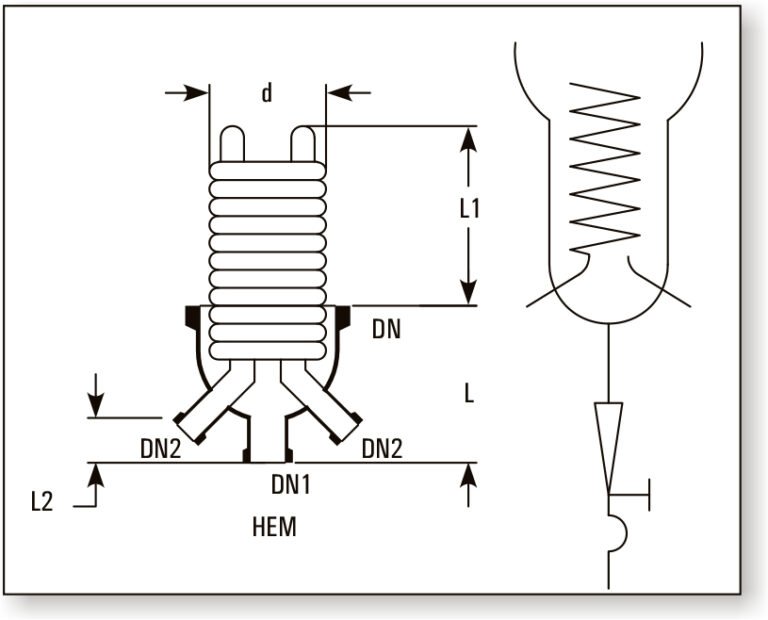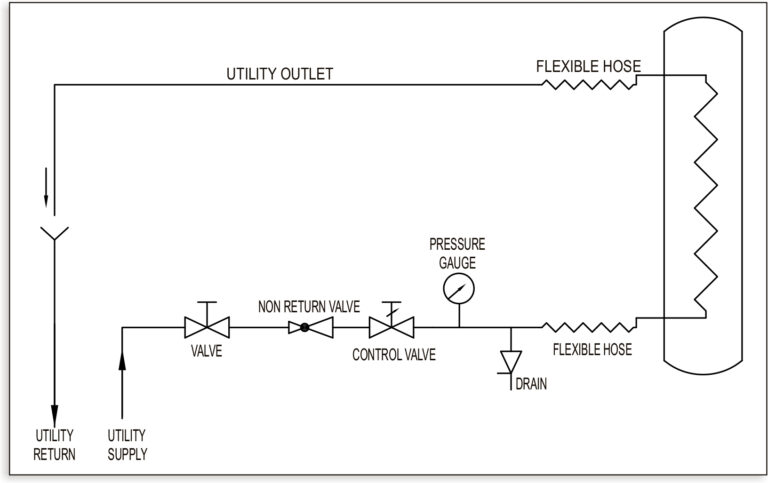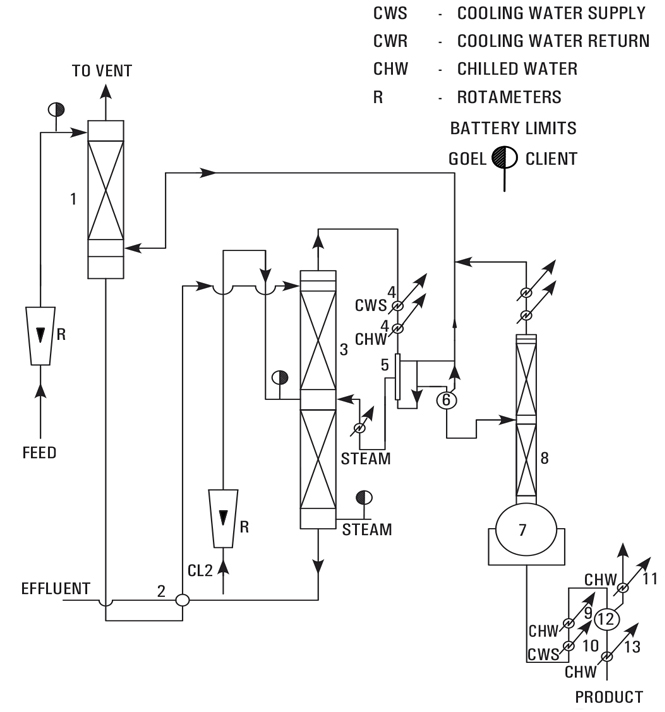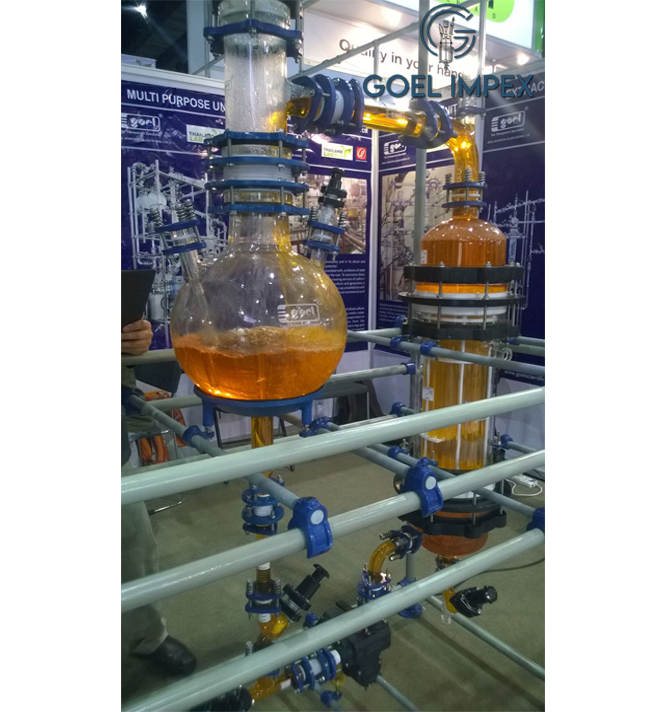Coil Condensers are used for condensation of vapours and cooling of liquids. Condensers are made by fusing number of parallel coils in a glass shell. Coils are made in different diameters using tubes of different bores.
The average co-efficient of heat transfer in coil condenser is considered as :-
- Condensation 200 – 270 Kcal/m2, hr, 0C appx.
- Cooling 100 – 150 Kcal/m2, hr, 0C appx.
| Cat. Ref. |
DN |
d/DN1 |
L |
L1 |
Type |
Actual |
Cross |
Free |
Max. |
|
HE3/3.5*
|
80 |
16 |
600 |
75 |
A |
0.35 |
5 |
1300 |
2 |
|
HE4/5*
|
100 |
19 |
600 |
75 |
A |
0.50 |
30 |
2400 |
4 |
|
HE4/6
|
100 |
19 |
750 |
100 |
A |
0.60 |
30 |
2400 |
6 |
|
HE6/10
|
150 |
25 |
600 |
100 |
B |
1.00 |
52 |
2600 |
9 |
|
HE6/15*
|
150 |
25 |
850 |
100 |
B |
1.50 |
52
|
2600
|
11 |
|
HE9/25*
|
225 |
25 |
800 |
110 |
B |
2.50 |
125 |
3300 |
18 |
|
HE12/25
|
300 |
25 |
600 |
125 |
B |
2.50 |
175 |
5700 |
25 |
|
HE12/40*
|
300
|
25
|
900
|
125
|
B
|
4.00
|
175
|
5700
|
35
|
|
HE16/40
|
400
|
25
|
600
|
125
|
B
|
4.00
|
450
|
6200
|
60
|
|
HE16/50
|
400 |
25 |
700 |
125 |
B |
5.00 |
450 |
6200 |
70 |
|
HE18/60
|
450
|
40
|
750
|
150
|
C
|
6.00
|
820
|
4800
|
100
|
|
HE18/80
|
450 |
40 |
900 |
150 |
C |
8.00 |
820 |
6200
|
110 |
|
HE24/120
|
600
|
50
|
1250
|
300
|
C
|
12.00
|
1520
|
6200
|
265
|
Precautions to be taken in use of coil condensers :
- Vapours should be passed through shell only.
- Maximum pressure of coolant should be 2.7 bars.
- Adequate flow of coolant should be used.
- Steam should not be used in coils.
- Coolant should not be heated to boiling point.
- Coolant control valve should be turned slowly.
- Coolant should be allowed to drain freely.
- Brine can be used in coils in a closed circuit.
- Water main should be connected with flexible hose.
- Ensure no freezing of water remaining in the coils.
- Condensers should be mounted vertically only.
- Condensers can be mounted in series to provide larger surface area.
Methods of Use of Coil Condenser :
Vapours from bottom
This method is simple to install over a reactor. However this results in condensate returning substantially at its condensing temperature. In this method care must be taken that condensate is not excessive that it can lead to “logging” the coils and create back pressure in the system. Generally a reflux divider is used below the condenser to take out the distillate.
Vapors from top
This method produce a cool condensate using the entire coolinlg surface area. This method should be used where the condensate can lead to “logging” of coils.
BOILERS
Boilers are used for vaporization of liquids by passing the steam in the coils. Boilers are made by fusing number of parallel coils in a glass shell. In Boilers, coils are designed to provide bigger cross section in the shell side as compared to condensers. o The average heat transfer in Boilers is considered as 350 Kcal/m2,hr, C at a steam pressure of 3.5 bar.
|
Cat. Ref.
|
DN |
DN1 |
DN2 |
L |
L1 |
Type |
Actual |
Free |
Jacket Cap. Litre |
|
HEB4
|
100 |
25 |
25 |
375 |
100 |
A |
0.15 |
40 |
2 |
|
HEB4/4
|
100 |
100 |
25 |
400 |
100 |
B |
0.15 |
40 |
3 |
|
HEB6
|
150 |
40 |
25 |
450 |
100 |
A |
0.35 |
50 |
5 |
|
HEB6/6
|
150 |
150 |
25 |
500 |
100 |
B |
0.35 |
50 |
7 |
|
HEB9
|
225 |
40 |
25 |
700 |
100 |
A |
1.00 |
150 |
16 |
|
HEB9/9
|
225 |
255 |
25 |
700 |
100 |
B |
1.00 |
180 |
20 |
|
HEB12/12
|
300 |
300 |
25 |
700 |
125 |
B |
1.30 |
330 |
40 |
Note on use of Boilers :
- Steam should be passed in the coils at a maximum pressure of 3.5 bar which is equalant to a temperature of 147 째C.
- For higher temperature (maximum upto 200 째C) heat transfer fluids can be passed in the coils. – Cold liquids
- Cold liquids should be preheated for better results.
- Boilers should bemounted in an external circulatory loop (as shown in figure) and not direct at the bottom of flask or column
- Under certain circumstances, boilers can be mounted in series to provide larger heat transfer area.
ANGLED HOSE CONNECTOR ASSEMBLIES
Metal/Plastic angled hose connector assemblies are available to connect the flexible hose to the condensers. These are provide with a mating flange, a rubber gasket and nut bolts.
| Cat.Ref. |
DN |
d |
L |
| PMC1 |
25 |
22 |
70 |
IMMERSION
Immersion heat exchangers are used to control exothermic reaction in glass vessels. They can be used with vessels having wider bottom outlet (type VSR and VSE). These are provided with a central hole through the coil battery so that a special, extended type, stirrer can be fitted which extends to the bottom of heat exchanger and provide through action. In most applications, cooling water is used in coils (max. pressure 2.7 bar g.), but they can also be used with steam (max. pressure 3.5 bar g.). In latter case the coils must be completely immersed in liquid. Immersions are not recommended for use with products which have a tendency to crystalise.
| Cat. Ref. |
DN |
DN1 |
DN2 |
L |
L1 |
L2 |
d |
Actual |
| HEM6 |
150 |
40 |
25 |
200 |
200 |
75 |
145 |
0.4 |
| HEM9 |
225 |
40 |
25 |
300 |
200 |
75 |
200 |
0.6 |
PRODUCT COOLERS
Product coolers are used for cooling of liquids, typically, for the cooling of distillates from the distillation columns. Unlike coil condensers, in product coolers, product travels through the coil battery and coolant through shell. This provides more resident time to the product to be cooled. For direct connection with distillate lines, all the product coolers are provided with 25 DN connections.
|
Cat.Ref.
|
DN |
DN1 |
DN2 |
L |
Actual HTA |
TYPE |
|
HEF1/1*
|
50 |
25 |
12 |
450 |
0.1 |
A |
|
HEF1/2*
|
50 |
25 |
12 |
600 |
0.2 |
A |
|
HEF1/3.5*
|
80 |
25 |
16 |
600 |
0.35 |
A |
|
HEF1/5*
|
100 |
25 |
19 |
600 |
0.5 |
A |
|
HEF1/10
|
150 |
25 |
25 |
600 |
0.7 |
B |
|
HEF1/15
|
150 |
25 |
25 |
850 |
1.25 |
B |
UTILITY CONNECTION FOR CONDENSER
When installing coil type heat exchangers appropriate precautions should be taken. The main points to be taken into account when planning to use these items as coolers are (See also flow chart below).
